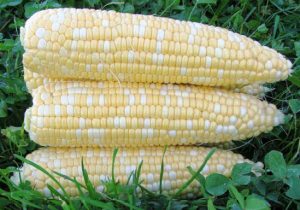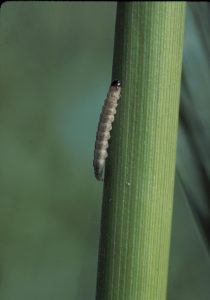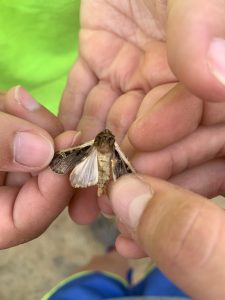Sweet Corn IPM Newsletter No. 4 – July 15, 2022

Sweet Corn IPM Newsletter – No. 4 – July 15, 2022
COOL NIGHTS SLOW PEST ACTIVITY
Fall Armyworm and Western Bean Cutworm Numbers Increasing
SAVE THE DATE! Highmoor Summer Tour: 1:30 - Pomological Society Meetings and Tour ($10), 5:00 – Supper ($25/person) is served, 6:00 - Vegetable and Small Fruit Tour (free). (If you just want to attend the Vegetable tours, you don’t need to register.) For More Information and to Register
SITUATION
Most of the state remains in very dry conditions but most fields that can be irrigated are getting adequate water and show good growth. Early silking corn in southern Maine is nearing maturity, so local corn should soon be showing up on farm stands soon. Recent cool night temperatures appear to have slowed evening flights of moths, so pheromone trap catches were down this week, reducing the need for spray coverage.

European corn borer: Larval feeding injury was not over the 15% control threshold for pre-tassel corn at any of our scouting sites, although low-level feeding activity was observed in most fields. Moth activity was also lower, with no sites over the 5-moth threshold for silking corn.
Corn earworm: Although much more silking corn is now available, moth counts were lower this week, most likely a result of cool evening temperatures, which reduced moth activity. A 6-day spray interval for fresh silking corn was recommended in Cape Elizabeth, and at one Wells site. All other sites were below threshold.
Fall armyworm: Fall armyworm moths were over the three-moth threshold for silking corn in Biddeford and New Gloucester. Both sites were not on a spray interval for corn earworm, so a spray to protect silking corn was recommended. As expected, larval feeding damage on leaves and tassels was more widespread this week but was not yet over threshold at any site.

Western Bean Cutworm: We’ve caught moths of this “new” pest at several locations this week. The larvae of western bean cutworms feed on corn plants and move into the ears through the silk channels or the husks, similar to fall armyworm. The threshold for feeding injury on plants is 8%. Sprays for corn earworm should protect silking corn from western bean cutworm as well. The optimal time for controlling the larvae is late pre-tassel to tassel when they move from the leaves and stalk into the ears.
Squash vine borer: Moths continue to be caught at all of our trapping sites this week, with numbers ranging from 7 to 31. Sprays are recommended when more than 5 moths are caught in a pheromone trap in a week, so it is likely that a spray is needed on all susceptible squash and pumpkins to prevent infestation. If you are not using pheromone traps, initiate control when you see the moths, or damage on plants. See the New England Vegetable Management Guide for control options.

Spotted wing drosophila alert: We are now catching spotted wing drosophila in traps set up in berry fields. These small fruit flies can cause serious fruit losses in late strawberries, raspberries, blueberries, and other soft fruits. For more information visit our website:
http://extension.umaine.edu/highmoor/news-events/.

Highmoor Farm, the Maine Agriculture and Forest Experiment Station in Monmouth will hold a summer tour and BBQ dinner on Wednesday, July 27, from 1:30 to 7:30 p.m. For information and registration go to:
https://extension.umaine.edu/highmoor/news-events/summer-tour/
Sincerely,
David T. Handley
Vegetable and Small Fruit Specialist
Highmoor Farm UMaine Extension Diagnostic
P.O. Box 179 Research Lab, Pest Mgmt. Unit
52 U.S. Route 202 17 Godfrey Drive
Monmouth, ME 04259 Orono, ME 04473
207.933.2100 1.800.287.0279
Sweet Corn IPM Weekly Scouting Summary
| Location | CEW
Moths |
ECB
Moths |
FAW
Moths |
%Feeding
Damage |
Recommandations / Comment |
| Biddeford | 0 | 0 | 3 | 13% | One spray on silking corn for FAW |
| Bowdoinham | 1 | 4 | 2 | 12% | No spray recommended |
| Cape Elizabeth | 3 | 0 | 0 | 2% | 6-day spray interval for silking corn |
| Dayton I | 0 | 0 | 0 | 4% | No spray recommended |
| Dayton II | 1 | 3 | 1 | 10% | No spray recommended |
| Farmington | 0 | 2 | 0 | 2% | No spray recommended |
| Garland | 1 | 0 | 0 | 0% | No spray recommended |
| Lewiston | 0 | 0 | 0 | 2% | No spray recommended |
| Lewiston II | 0 | 0 | 0 | 2% | No spray recommended |
| New Gloucester | 1 | 0 | 3 | 0% | One spray on silking corn for FAW |
| Oxford | 0 | 0 | 0 | 6% | No spray recommended |
| Sabattus | 1 | 0 | 0 | 0% | No spray recommended |
| Wayne | 0 | 0 | 0 | 2% | No spray recommended |
| Wells I | 2 | 1 | 1 | 5% | 6-day spray interval for silking corn |
| Wells II | 1 | 0 | 0 | 4% | No spray recommended |
CEW: Corn earworm (Only fresh silking corn should be sprayed for this insect.)
ECB: European corn borer
FAW: Fall armyworm
| European Corn Borer Thresholds
Whorl stage: 30% or more of plants scouted show injury. Pre-tassel-silk: 15% or more of plants scouted show injury. Silk: 5 or more moths caught in pheromone traps in one week. |
Corn Earworm Spray Thresholds for Pheromone Traps
| Moths caught per week | Moths caught per night | Spray interval |
| 0.0 to 1.4 | 0.0 to 0.2 | No spray |
| 1.5 to 3.5 | 0.3 to 0.5 | Spray every 6 days |
| 3.6 to 7.0 | 0.6 to 1.0 | Spray every 5 days |
| 7.1 to 91 | 1.1 to 13.0 | Spray every 4 days |
| More than 91 | More than 13 | Spray every 3 days |
Thresholds apply only to corn with exposed fresh silk. Lengthen spray intervals by
one day if the maximum daily temperature is less than 80°F.
IPM Web Pages:
http://extension.umaine.edu/ipm/
http://www.pestwatch.psu.edu/sweet_corn.htm
https://ag.umass.edu/integrated-pest-management/
Where brand names or company names are used, it is for the reader’s information. No endorsement is implied nor is any discrimination intended against other products with similar ingredients. Always consult product labels for rates, application instructions and safety precautions. Users of these products assume all associated risks.
The University of Maine is an equal opportunity/affirmative action institution.
